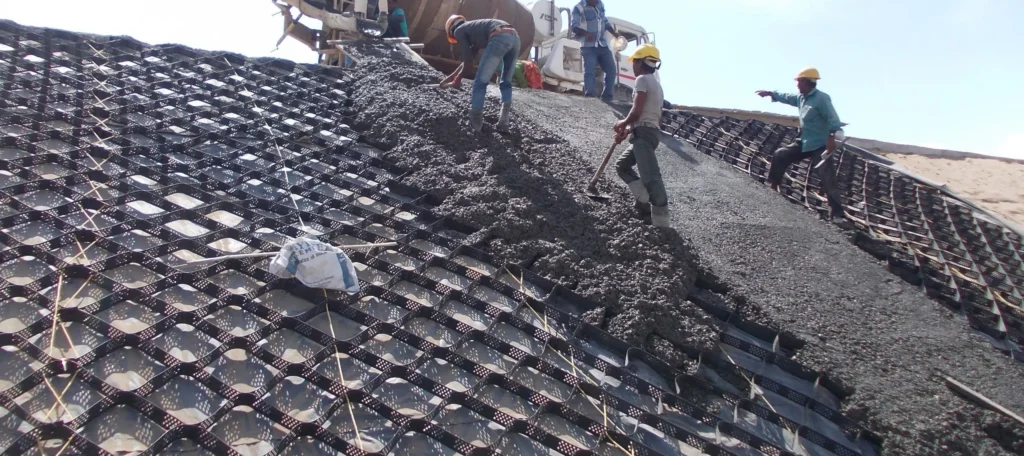Infrastructure development is at the heart of modern society, enabling connectivity, transportation, and urbanization. However, constructing resilient and long-lasting infrastructure is a complex challenge, especially in areas with weak or unstable soil. This is where geogrids, a vital geosynthetic material, come into play. In this article, we’ll explore geogrid sheets, their types, applications, and the pivotal role they play in enhancing the durability and sustainability of infrastructure projects.
What Are Geogrid Sheets?
Geogrid sheets are a type of geosynthetic material composed of polymers like polypropylene or polyester. These materials are processed to create a grid-like structure with apertures that vary in size and shape. The main purpose of These sheets is to provide reinforcement to the soil, enhancing its load-bearing capacity, stability, and overall performance. They act as a strengthening layer that distributes loads more effectively, making them a valuable asset in construction and civil engineering projects.
Types of Geogrid Sheets

Geogrids come in various types, each tailored to specific applications and site conditions:
1. Uniaxial Geogrids:
Uniaxial geogrids have openings that are primarily oriented in one direction. They are designed to provide reinforcement in a single axis, making them suitable for applications like soil retaining walls, embankments, and steep slopes. These geogrids excel at resisting tensile forces along their primary axis.
2. Biaxial Geogrids:
Biaxial geogrids have openings that are evenly distributed in both the longitudinal and transverse directions. This balanced reinforcement is beneficial for applications where loads act in multiple directions, such as stabilizing pavements, roadways, and parking lots.
3. High-Modulus Geogrids:
High-modulus geogrids are engineered for projects requiring high tensile strength and stiffness. They are often used in applications such as reinforced soil walls, bridge abutments, and other heavy-duty infrastructure projects.
4. Low-Modulus Geogrid Sheets :
Low-modulus geogrids are more flexible and are designed for applications where differential settlement or lateral movement may occur. These geogrids are suitable for projects like pavement overlays and road rehabilitation.
Applications of Geogrid Sheets

Geogrid sheets find extensive use in a wide range of construction and civil engineering applications:
1. Retaining Walls:
Geogrid sheets provide crucial reinforcement for retaining walls. They enhance the stability and load-bearing capacity of the soil behind the wall, preventing erosion and failure.
2. Slope Stabilization:
On steep slopes, geogrid sheets prevent soil erosion and landslides by reinforcing the soil. They improve slope stability, reducing the risk of catastrophic failures.
3. Pavement and Road Construction:
Geogrid sheets are used in road construction to improve the performance of asphalt and concrete pavements. They distribute loads, reduce cracking, and extend the lifespan of roadways.
4. Embankments and Foundations:
In the construction of embankments and foundations, These sheets increase the bearing capacity of the soil, minimizing settlement and ensuring the integrity of structures.
5. Erosion Control:
Geogrid sheets are employed in erosion control systems, such as retaining walls and reinforced vegetation systems, to prevent soil erosion and promote vegetation growth.
6. Landfills and Environmental Protection:
In landfill construction, geogrid is used to create composite liners that contain waste and prevent contaminants from leaching into the environment.
Benefits of Geogrid Sheets

- Enhanced Load-Bearing Capacity: Geogrid sheets distribute loads more effectively, reducing the risk of soil settlement and structural damage.
- Improved Soil Stability: They enhance the stability of soil, particularly in areas with weak or expansive soils.
- Cost Savings: Geogrid can lead to cost savings by reducing the amount of excavation, fill material, and maintenance required for a project.
- Sustainability: By extending the life of infrastructure and reducing maintenance needs, these sheets contribute to sustainable construction practices.
- Erosion Prevention: Geogrid sheets play a vital role in erosion control, protecting landscapes, and preventing soil loss.
- Versatility: With various types available, sheets can be tailored to suit different project requirements.
Conclusion
Geogrid sheets are an indispensable component of modern construction and civil engineering projects. Their ability to reinforce soil, enhance stability, and distribute loads makes them essential for creating resilient and sustainable infrastructure. As the demand for infrastructure development continues to grow, geogrids will remain a critical tool in ensuring the longevity and safety of construction projects. By harnessing the power of these sheets, we can build a stronger, more connected, and environmentally responsible future for our communities.

